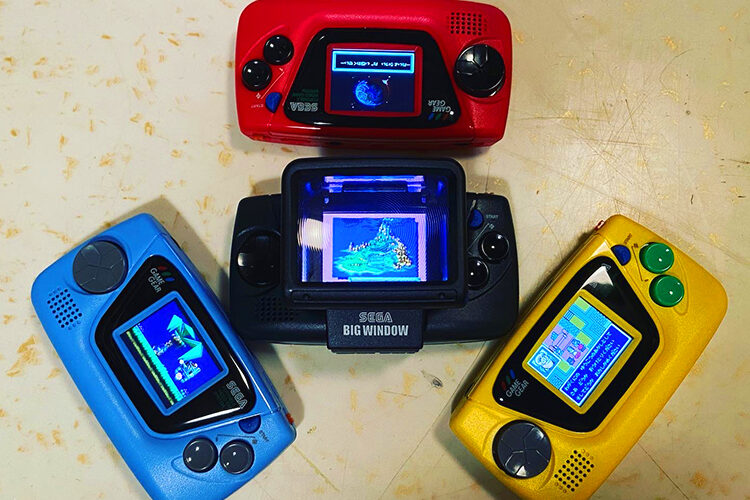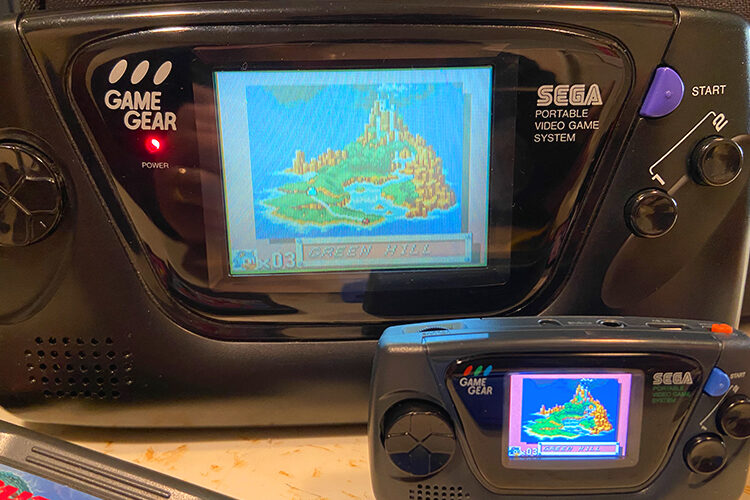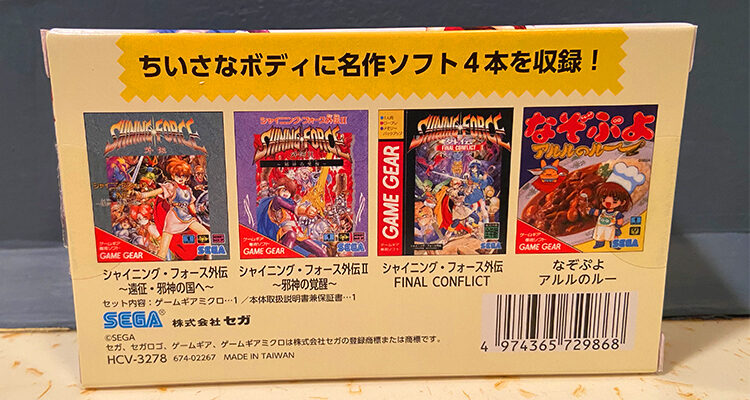In June 2020, SEGA revealed the Game Gear Micro. Prior to the full announcement, fans speculated on if this would be the successor to the SEGA Genesis/Mega Drive Mini, how big the actual device was, how many games would be on the handheld and if it would receive a western release. Once the details were confirmed, internet reaction – specifically from westerners – was largely negative. With dimensions of 80×43 mm (about the size of a Dreamcast VMU) and four colors featuring four unique games each, the Micro truly was living up to its name. Micro in size, micro in game lineup, and micro in not living up to expectations set by the Genesis/Mega Drive Mini.
Now, five months later, I have the full lineup in hand (literally, I can hold all four in one hand!) and can make my own determination on the Game Gear Micro. Is it worthy of an import?

Within the SEGAbits community, there has been disagreements over the Game Gear Micro. Some members had hoped for something larger, pre-loaded with 30+ games and with video out. Others saw that this was a Japanese focused machine targeting more casual fans and those with the fascination of tiny things (which is an actual craze in Japan). I personally see both sides’ strengths and weaknesses. A Game Gear Mini at half the size of the original Game Gear, pre-loaded with 30+ games and video out would have been awesome.
However, I could also see such a device defeating the original mission SEGA Toys and M2 set out on which was to make a fun bite-sized nostalgic toy for the Game Gear’s 30th anniversary. SEGA has said themselves that they chose “Micro” for a reason, because this is not a Mini console in the same league as the Mega Drive Mini.
A Game Gear Mini would push the project in a very different direction, one that moves away from a nostalgic toy and towards a handheld console which, also by SEGA’s own admission in interviews, would have been a much more costly and involved process. A quick Google search for “open source handhelds” will bring up a number of projects that would blow any SEGA produced Game Gear Mini out of the water, and from my own experience I much prefer an handheld open source emulator with the ability to play any game imaginable to a pre-loaded handheld.
I think SEGA knew this too, as the Game Gear Micro is a very different thing and for (almost) all the right reasons. If it sounds like I’m defending the Micro, it’s because I do lean more towards this direction for the handheld and I don’t think it’s worth dwelling on what we DIDN’T get but dissecting what we DID get.
Upon opening the box and sliding out the cardboard tray containing the Micro, neatly tucked into a clear plastic baggie, the sheer tininess will hit you hard. Despite the photos of a Game Gear Micro next to a VMU and my own experiments in printing out a scale sized paper cutout of the Micro, it was still smaller than I expected. Opening the back and popping in two AAA batteries was easy, no tiny screwdrivers required, and controls are intuitive because it mimics the larger original Game Gear.
Controls are the same, but obviously much tinier. However, using the VMU as a comparison, the Micro has the same feel in terms of size but with the Micro’s screen spacing out the directional pad and buttons, the Micro is far easier to control than a VMU ever was. The directional pad is probably the weakest aspect to the Micro’s controls. It is intuitive and works in controlling games, but it has that same sort of stiff feel the original Game Gear has. Perhaps its because of the Micro’s size that pressing with the usual strength one would on a Game Gear feels “wrong” because you’d think you’ll break it, but the d-pad is durable enough to withstand the force. I will say that after an hour of gameplay, I stopped noticing this because perhaps I stopped treating the tiny Micro so delicately.
The sound of the Micro’s speakers is impressively loud. At full volume the device doesn’t sound tinny and can even drown out an original Game Gear. Additionally, the headphone port is an excellent addition and gives the listener a great audio experience. Perhaps the strongest aspect of the Micro is what would would make or break the handheld: the screen. Despite being the size of a postage stamp, the Micro’s screen is bright, crisp and lacks the signature blur of the original handheld. In terms of color, games appear as they were intended to. Simplistic games like action, platformers and puzzle games play well, but more involved games like RPGs would require the Big Window, a bonus for those who buy all four models.
Accessories like the Big Window have been seen as kind of a joke over the years, often by retro game YouTubers who like to poke fun at any old gaming oddity. But as somebody who was there when the Game Gear released, accessories like this were awesome. Using a piece of magnifying plastic, the Game Gear’s screen appears 25% larger and is better seen from a comfortable distance. With the Game Gear Micro, you are given that same effect and it honestly makes for a great gaming experience. I sat with the Micro two feet from my face and played through Sonic the Hedgehog comfortably.
The biggest test for the Micro was whether I could forget about the handheld’s insanely small size and just get into the games, and by and large I was able to thanks to the screen quality, sound options and (at times) the Big Window Micro accessory.
Regarding battery life, let me first address a falsehood that has been thrown out constantly from gaming press since the Micro’s announcement: the original Game Gear only had a two hour battery life if you used shitty batteries. Low energy AA batteries meant for TV remotes were never meant for the Game Gear. Top of the line powerful batteries, which can also be bought as rechargeables, can yield as much as 6-8 hours of life for the original Game Gear. The Game Gear Micro takes two AAA batteries and SEGA has said the handheld has 2-3 hours of gameplay. I have not run a test myself, but I am curious if top of the line AAA batteries would see longer playtimes. If you don’t want to use batteries, the Micro has a port for a micro USB power input. Should the unit reach 5%, a randomized screen featuring a SEGA character low on energy appears on the screen.
Games, which we will cover next, each have two save slots which players can access by holding the start button.
The Game Gear Micro comes in four flavors (please don’t eat the Micro!), with each representing a real color of the console released in the 90s. The original BLACK is the most plain yet iconic of the four and the included games reflect that classic feel. Included are Sonic The Hedgehog, Puyo Puyo 2, OutRun and Royal Stone. The game selection covers a variety of genres and represent some of the handheld’s best titles. These games are also the most english-friendly, with only the RPG Royal Stone presenting a language barrier. It’s worth noting Royal Stone never had an english release, but a fan translation exists, so one would play alone to a walkthrough video and get enjoyment out of the game.
The Verdict: If one was only interested in importing one Game Gear Micro, I would say black is the way to go. Solid game selection and an iconic color.
The light BLUE Game Gear Micro is based off the original Japanese light blue model. The four games included are Sonic & Tails (Sonic Chaos), Gunstar Heroes, Sylvan Tale and Baku Baku Animal. The lineup is the second most import friendly and like the black model, represents four different genres. Sonic & Tails is a solid Game Gear Sonic title. Gunstar Heroes (a Japan regional exclusive back in the day) is a special inclusion because the game was originally developed by M2, and much of the original staff returned for this Micro port. Refinements, bug fixes and other easter eggs make this a standout title not only on the blue model, but amongst all the included titles. Sylvan Tale is a Japan exclusive action RPG that, like Royal Stone, has an english fan translation which would make a walkthrough video helpful in starting players off. Baku Baku Animal is a bizarre, but very fun puzzle game. Menus are in Japanese, but are easy enough to navigate and with an official english version one can easily figure things out with some side-by-side comparisons.

The Verdict: The diverse lineup of quality games make the blue model an easy second best choice for english speaking fans looking to import.
The RED Game Gar Micro is the most attractive of the bunch, and the color is based off of three original Game Gears: a basic red, a Coca-Cola branded red and a Magic Knight Rayearth red. The game selections suggest that the original red model was the inspiration, as there is no Magic Knight Rayeath to be found. Instead, the game lineup includes the ATLUS developed Megami Tensei Gaiden: Last Bible, its followup Megami Tensei Gaiden: Last Bible Special, The GG Shinobi and Columns. The ATLUS RPGs are sure to delight Japanese fans and ATLUS fans, but for westerners they are not very accessible. Fan translations exist, so fans can do as I have been suggesting and follow along to a video playthrough. The GG Shinobi and Columns, meanwhile, are very import and english friendly and are fun and iconic Game Gear titles.

The Verdict: It’s difficult for me to suggest the red model to anybody but hardcore ATLUS or Shinobi fans. Unless you are buying the four Micro bundle, I would say pass on importing solely the red model.
Lastly we have the YELLOW model. Visually, the yellow model with tis green buttons just pops and looks incredibly cool. It’s a shame that it is also the least import friendly. Pre-loaded with three Shining Force games (Shining Force Gaiden: Ensei Jashin no Kuni e, Shining Force: The Sword of Hajya and Shining Force Gaiden: Final Conflict) as well as the puzzle/RPG Nazo Puyo Arle no Roux, this is the model that Japanese players are likely to spend the most time playing and westerners are going to find the most inaccessible. The Puyo Puyo game has RPG elements, and also traditional puzzle gameplay, and is a fun curiosity. But none of the titles are pick up and play unless you can read Japanese.
The Verdict: Unless you are a hardcore Shining Force fan, or can read Japanese, avoid this model unless you are buying the full set.
Overall: I would say the Game Gear Micro exceeded my expectations. What I was prepared to approach as a novelty toy actually presented a gaming experience, albeit very much on the tiny size. Despite the diminutive experience, controls, sound and visuals work well. If you are a casual Game Gear fan, I would pass on importing the full lineup, but if you like what you see I would suggest importing at least one of the units. However, if you are a hardcore SEGA fan who loved the Game Gear and enjoyed the recent Genesis/Mega Drive Mini, I would say the full Micro line-up is worth checking out.
Ad:


















Thanks for the great review.
In my humble opinion, I think the blue one is the best for importing. Puyo Puyo 2 (not Nazo Puyo 2) is great, by it’s by far the hardest game in the series with a very tough AI (and the GG port is even harder then the Mega Drive one), and Baku Baku, while not as interesting, is also a good, more laid back puzzle.
Royal Stone is kind of unplayable without being able to read Japanese. Okay, Sylvan Tale is also in Japanese, but it’s an action game and you can actually figure out how to progress in the game with very little trial and error, unlike Royal Stone and its menus.
Sonic Chaos is an easier game for the small screen than Sonic 1 in my opinion, and while OutRun is great, I think Gunstar Heroes is also a much better, more impressive game.
I wish it had Columns instead of Baku Baku Animal, but still, I think the blue one is the best. I can easily see the black and blue ones getting more expensive in the future, as they are the ones who will have the most demand from westerners.
how do you buy it and were do you buy it
Got my delivery today. I got black because I have no nostalgic relationship with the other colors. Might import red now that I know it’s sort of worth the money. It’s a good collector’s item. The screen is small, but of good quality. The entire unit is built really well. What kills the product is the extremely BAD d-pad. It’s mushy and unresponsive. I can’t stress enough how terrible it is. Puyo Puyo is unplayable with it because half the time you press down, it also goes either left or right. Same with Sonic, trying to roll while running is way harder than it should be.
Everything else about the unit is great, just wish they put more money into making the d-pad better because it really takes away from the fun of playing the games.
Sad to know that no PS franchise (Phantasy Star Adventure and Phantasy Star Gaiden) could make it on these releases. Phantasy Star Adventure may be a bit boring, but Phantasy Star Gaiden is a nice RPG.
Where can we buy these? Amazon Japan?
Play Asia is sold out at the moment.
I pre-ordered mine on Amazon Japan. Arrived in 2 days. They still have them in stock, it seems. Just search for ゲームギアミクロ
Seriously Sega why?